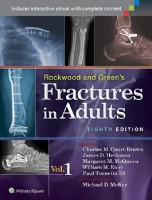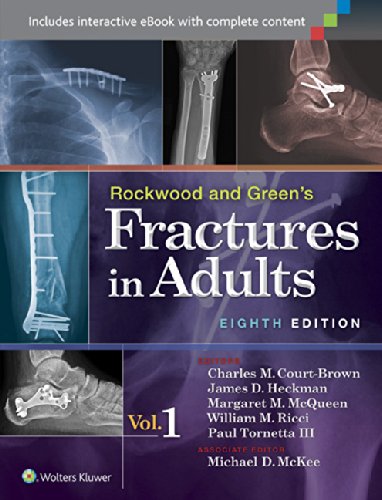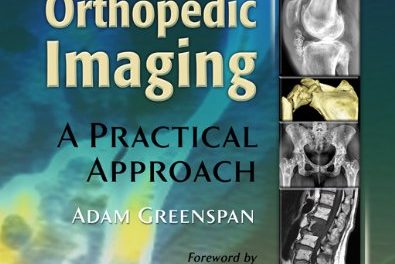 Editors: Charles M. Court-Brown, MD, James D. Heckman, MD, Margaret M. McQueen, MD, William M. Ricci, MD, and Paul Tornetta III, MD. Associate Editor: Michael D. McKee, MD
Editors: Charles M. Court-Brown, MD, James D. Heckman, MD, Margaret M. McQueen, MD, William M. Ricci, MD, and Paul Tornetta III, MD. Associate Editor: Michael D. McKee, MD
Publisher: Wolters Kluwer | Lippincott, Williams & Wilkins – 2769 pages, plus 30-page Index
Book Review by: Nano Khilnani
Orthopedic trauma is a discipline that has been growing in the last few decades, and many advances have occurred, the editors point out. Information, knowledge and insight about those developments have been incorporated into this eighth edition.
The first edition of this book was published about four decades ago, in 1975. At that time there were virtually no orthopedic trauma specialists in most countries, and fractures were usually treated non-operatively. The number of people who died after severe trauma was “considerable,” the editors write.
Some 120 orthopedists including orthopedic surgeons, and specialists in other related fields, from the United States and 10 other countries – Australia, Canada, Colombia, Czech Republic, Germany, India, Israel, Scotland, Switzerland, and United Kingdom – were contributing authors of this book.
The contents of this book have quite simply been organized into two volumes and four sections mentioned below. The 62 chapters have been organized around these four sections:
Volume 1
- Section One: General Principles
- Basics
- Principles of Treatment
- Fracture Types
- Complications
- Section Two: Upper Extremity
Volume 2
- Section Three: Spine
- Section Four: Lower Extremity
Your book purchase includes a complimentary download of the enhanced eBook for iOS, Android, PC and Mac. This eBook features:
- Complete content with enhanced navigation that can be accessed anywhere, even without a data connection
- Find information instantly using powerful search tools and smart navigation cross-links
- Highlighting tool for easier reference of key content throughout the text
- Ability to take and share notes with friends and colleagues
- Quick reference tabbing to save your favorite content for future use
To download your eBook, do the following:
- Go to http://solution.lww.com/access
- Enter the Access Code found by scratching off the grey sticker on the inside front cover of your book
- Enter your information, click Submit, and follow the on-screen instructions to start reading your eBook.
If you have questions or concerns, call 1-800-468-1128, or email: [email protected]
The material in the 62 chapters of this book is organized in such a clear way that you can look at the outline of topics at the beginning of each chapter and be able to know exactly what is covered or not covered.
As an example, let us look at chapter 2, Classification of Fractures. You will find at the top of the first page of this chapter, an outline of topics covered. In this chapter, you will find:
- Introduction
- Purposes of Fracture Classification Systems
- History
- Types
- Examples of Fracture-Specific Classification System
- Examples of Universal Classification Systems
- Classifications of Soft-Tissue Injury Associated with Fractures
- Limitations of Fracture Classification Systems
- Current Usefulness
- The Future of Fracture Classification Systems
All the topics named above are discussed to some length in pages 43 through 57 of this book, numbering 15 pages. A large variety of study aids are provided to help you learn. These consist of, but are not limited to boxes, figures, highlighted text areas, photos, tables, and other types of visual material. Finally, a long list of References is provided at the end of the chapter for your further study.
These are among some of the benefits of using this book:
- New chapters on: Management of the Geriatric or Elderly Patient; Management of Bone Defects;; Psychological Aspect of Trauma
- New authors from countries including India, China, Columbia, Greece, and Denmark
- New 10 full length videos added to the video library. All videos feature easy navigation so you can go directly to specific steps in the procedure, or watch the entire procedure from start to finish
- Pearls and Pitfalls and preventive measures listed for all procedures
- NEW Time-saving outline template for easy quick-reference
- “Before the Case” checklists of all necessary equipment for each surgical procedure
- Preferred Technique section provides algorithms explaining each author’s choice of preferred procedure
- Full-color operative photos, tables, x-rays, diagrams, and more than 500 line drawings of surgical procedures
This is a comprehensive text on fractures in adults. It is s must-have book for anyone planning a career in, or is already in orthopedics. The editors of this book have done a marvelous job of compiling, organizing, and presenting the highly valuable material contained in this unique book.
Editors:
Charles M. Court-Brown, MD, FRCS Ed (Orth) is Professor of Orthopedic Trauma at the Royal Infirmary of Edinburgh, in Edinburgh, United Kingdom.
James D. Heckman, MD is Editor-in-Chief of The Journal of Bone and Joint Surgery in Needham, Massachusetts; Clinical Professor of Orthopedic Surgery at Harvard Medical School; and Visiting Orthopedic Surgeon at Massachusetts General Hospital in Boston, Massachusetts.
Margaret M. McQueen, MD, FRCS Ed (Orth) is Professor of Orthopedic Trauma at the University of Edinburgh, in Edinburgh, United Kingdom.
William M. Ricci, MD is Professor and Chief of Orthopedic Trauma Service in the Department of Orthopedic Surgery at Washington University School of Medicine in St. Louis, Missouri.
Paul Tornetta III, MD is Professor and Vice Chairman of the Department of Orthopedic Surgery at Boston University School of Medicine; and Director of Orthopedic Trauma at Boston Medical Center in Boston, Massachusetts.
Associate Editor:
Michael D. McKee, MD, FRCS (C) is Professor of Upper Extremity Reconstructive Service in the Department of Surgery in the Division of Orthopedics at St. Michael’s Hospital and the University of Toronto in Toronto, Canada.







